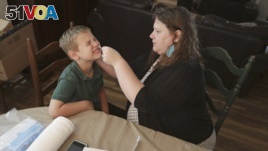19 August 2020
At Mendy and Joe McNulty's home in Mount Juliet, Tennessee, coronavirus testing supplies are in the kitchen. The parents gather there with their two sons to do home tests in a new study involving American families.
The McNultys are among about 2,000 families in 11 U.S. cities taking part in a DIY, or do-it yourself, study to learn more about the coronavirus. In all, the experiment involves around 6,000 people.

Mendy McNulty swabs the nose of her son, Andrew, 7, Tuesday, July 28, 2020, in their home in Mount Juliet, Tenn. (AP Photo/Mark Humphrey)
The families have no in-person contact with researchers. They get the necessary testing supplies in the mail.
"This virus is so unknown. Any little bit we can do felt like we were doing something to help," Mendy said, explaining why the family chose to take part.
The study looks for answers to some of the most difficult questions about COVID-19. How many U.S. children and teens are infected? How many children who are infected show no symptoms? How likely are they to spread it to other children and adults?
Dr. Tina Hartert of Vanderbilt University is leading the government-financed study. She recently told the Associated Press that "we just don't know yet the degree to which children can transmit the virus." Transmit is a verb that means to cause a virus or disease to be given to others.
Evidence from the U.S., China and Europe shows that children are less likely to become infected with the virus. They are also less likely to become seriously ill when they do get sick.
There is also data suggesting that young children do not transmit the virus very often. But the data does suggest that children age 10 and over may spread the virus just as easily as adults. The new study aims to find better evidence.
The families collect their own nasal swabs for COVID-19 tests. Less often, they also collect blood and stool samples. The samples are sent off by mail. Subjects receive text messages that ask about possible symptoms and that remind them to test.
The study could help give information about the safety of in-class education during the coronavirus crisis. However, results are not expected before the end of the year.
The exact number of COVID-19 cases in children remains unclear. The Centers for Disease Control and Prevention says that at least 175,000 cases have been confirmed in those aged 17 and under. Those cases make up less than 10 percent of all confirmed cases in the U.S.
But health experts say the true number is likely much higher because many children do not get tested.
The family study is also investigating whether children with asthma or allergies might have some protection against COVID-19. Experts do not know why that might be the case, said Dr. Anthony Fauci, director of the National Institute of Allergy and Infectious Diseases. The institute is paying for the research.
As a mom, former school teacher and scientist, Hartert wants to better understand the coronavirus. She says it is possible that none of the families will get infected. But that possibility is highly unlikely, given the number of COVID-19 cases across the country, she added.
Mendy McNulty says so far her family has remained healthy. She and her husband are both 39 and don't feel too worried about getting sick.
She is waiting to see what happens when her children return to school in mid-August. They will go to school two days a week - with face coverings and social distancing - and do online learning three days a week. "I am prepared to bring everyone home" if outbreaks occur, she said.
McNulty said the boys — 7-year-old Andrew and 9-year-old Hudson — were happy to take part in the study. She helps them do the nose swabbing, and they both say it does not really hurt.
Dr. David Kimberlin says he and other health experts have been waiting for the kind of data the family study will provide. "Generally speaking, the virus behaves differently in children than adults," said Kimberlin, a professor at the University of Alabama at Birmingham. "Why is that? We just need to know so much more."
I'm John Russell.
Lindsey Tanner reported on this story for the Associated Press. John Russell adapted it for Learning English. Bryan Lynn was the editor.
____________________________________________________________
Words in This Story
symptom – n. a change in the body or mind which indicates that a disease is present
nasal – adj. always used before a noun : of or relating to the nose
swab – n. a small piece of soft material sometimes on the end of a small stick that is used for applying medicine, cleaning a wound, etc.
stool – n. medical : a piece of solid waste that is released from the body
sample – n. a small amount of something that gives you information about the thing it was taken from
asthma – n. medical: a physical condition that makes it difficult for someone to breathe
allergy – n. a medical condition that causes someone to become sick after eating, touching, or breathing something that is harmless to most people
outbreak – n. a sudden start or increase in the spread of a disease or fighting